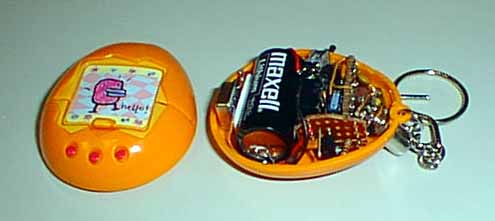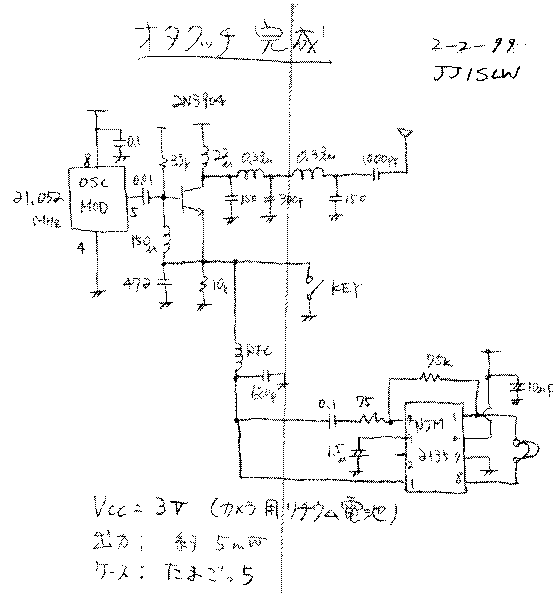THE OTAKUCHI / 21MHz QRPp CW Transceiver


One summer day in Japan in 1998, I visited Ham festival in Tokyo for the first time in many years. Our university club had a booth there for which I was extremely glad. I felt I must spend some money for the members. They sold can type crystal oscillator module for 21.052MHz, So I bought a bunch for no particular application.
I recently read that the condition of 15m band is getting better for the new sun spot cycle. My mind trips back to my golden time of 15m band. Home made 6 elements and 5W QRP reached to Central America from Japan with 59 report! I was amazed how QRP works!
Lets' make the RIG for 15m! I immediately started to check my junk box to see what I have for the radio. I started to think what kind of housing to be used.
My PIXIE2 fits nicely with ALTOIDS can. It was very convenient to take them out to the field. 15m band needs more gain than the PIXIE2 configuration. NE602? Or MOS FET and DBM. My imagination spread the world.
I checked my QRP note (the note I used to pool my idea for QRP RIG) and found interesting note; PIXIE2 modification for the simple small transceiver to fit the case of "TAMAGOCHI", the popular virtual pet. BINGO, that's it!!
I decided to made a QRPp radio using can type oscillator. I name it "OTAKUCHI". It means "RADIO GEEK" or Geekish TAMAGOCHI…whatever!
The development concept is the following:
- Simplified circuit
RIT can not be implemented due to the use of can type oscillator. Thus, let's make it simple as just to make the QRPp TX comes with receiving feature. It worth a million than nothing!
- Some improvement over the PIXIE2:
I experimented a new QSK method to sleep audio amplifier during the TX mode. Also, RF choke was implemented to reduce the AM reception.
- TAMAGOCHI housing:
I used a TAMAGOCHI housing which was sold as "TAMAGOCHI GUM" when TAMAGOCHI was hot! It looks cute!! That's why I can name it "OTAKUCHI". Perfect naming! Isn't it!!。
The case is measured 2 inch by 1.5 inch. A stereo jack, a snap switch, an RCA connector for antenna and a battery…there is not enough space to fit all of them.
After several trial and errors, my conclusion is the following
- Use 3V lithium battery for camera flush
- Stereo Jack to hold the battery. Other end was made by plastic board
- Stereo jack handles both key input and audio out.
- Battery is connected to power switch by connectors
- Use copper tape to provide shielding
The circuit is shown below:

This is a deliberative of PIXIE2. The original oscillator circuit is replaced with can type oscillator. Also, LM386 is replaced with NJM2135M, a 3V BTL audio amplifier from New Japan Radio. Those modifications made this rig to work at 3V supply. The can type oscillator and PIXIE2 mixer also work at 3V without any modifications.
The key of my experiment is to use power shutdown function of the audio amplifier. The chip will be in the sleep-mode when control pin is low. This is a perfect match with PIXIE2 mixer. In addition, no 100uF de-couple cap may help reducing the POP noise.
Transmitter is very stable, With my cheaply made RF probe, I got a half of the my PIXIE2 reading on a volt meter. The half of voltage means quarter of the power. Therefore, I estimate 5mW output. Not bad for 3V.
By the way, a old analog tester and home made an RF probe (a shotkey diode, 50 ohm and 0.1uF assembled in a plastic box) are all testing equipment. Yes, That's all folks needed to build this tiny little OTAKUCHI.
The receiver had some problem. The audio gain is too low. I reduced a resistance connected in serial with a input of the chip to increases the gain. 75 ohm is the minimal value for not to have oscillation. If you will make the one, I would recommend you to add one transistor amplifier. This will avoid unstable behavior.
With the parameter shown in the diagram, I could listen to several QSO's with relatively slower keying. I tried several improvements, but I fixed the parameters as is. It is not a 100%, but not too bad.
Unlike the 7MHZ band, I felt more RF gain for conformable receiving. I may need more time to determine how it is working. At least I listened several stations from East Coast. This indicates it is functionally working.
How about QSK improvement over the conventional LM386 approach?
Because I used one DC de-coupling capacitance (because I need to feed both keyer line and audio into the stereo jack), The first keying generates a pop sound. Otherwise, it is very clear during the transmission. My concept works. But, need more improvements.
Anyhow, I built a 15m RIG. Even making a contact with my 20mW PIXIE2 was enough challenge, the TAMAGOCHI situation is truly just for the RADIO GEEK. Besides, this rig has neither VXO nor RIT. Can I make a contact in the middle of CW band with no RIT? Who knows?
It is all up to you and your equipment to make it happened. Whenever you have a free time, please tune in at 21. 0526 with no filter. Someday, I will write a big article featuring "I DID IT! QRPp works!".
Do not tune the exact frequency. Please remember I do not have RIT!! Hell of the demand, but; Thank you for your cooperation in advance.